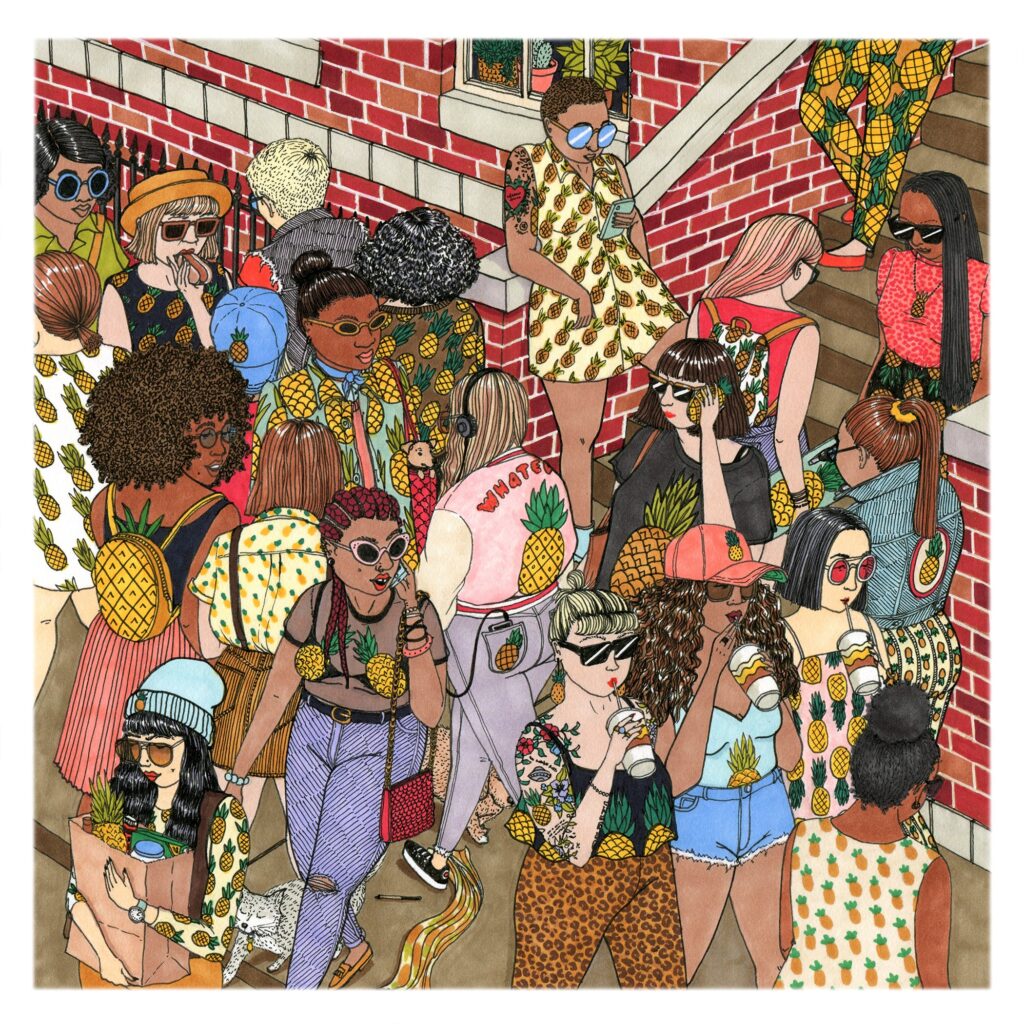
CONTENTS
IntroductionWhere, though, did it all begin?
The surprising significance of the pineapple
Pineapple as the feminist symbol
Conclusion
Introduction
Pineapples, in the past couple of years, have become the de facto decoration. Embroidered into jeans, woven into silk blouses, turned into tiny handbags, printed onto wallpaper, emblazoned on cell phone cases: no object in our world is away from this tropical fruit. Much like the peace signs and smiley faces of the ’70s, the daisies of the ’90s, and how we “put a bird on it” in the mid-aughts, the pineapple has emerged as the icon that will represent the times we live in now.
Where, though, did it all begin?
Because it was one of the fruits that Christopher Columbus and other European explorers were bringing back from the Americas, the pineapple first served as a prestige symbol. It took the Europeans many hundred years to learn how to cultivate the fruit; in the late seventeenth century, Barbara Palmer, the mistress of King Charles II, began cultivating them in her “hothouse.” Which means it was a big deal to have a pineapple in your house. So much so that there was a rent-a-pineapple program in place at the time so that different hostesses could alternately display the exotic fruit in their homes. As pineapples became more widely available over time and less associated with status, they started to be used as signs of welcome instead.
The surprising significance of the pineapple
However, if you bring up the pineapple with a bunch of modern-day fashion connoisseurs, they will certainly all bring up Stella McCartney’s spring 2001 collection for the French brand Chloe. Stella’s youthful, humorous approach to the world of “high fashion” was seamlessly incorporated into the collection, as evidenced by halter maillots with pineapple designs placed at the crotch thoughtfully.
Many people are aware that pineapples are associated with hospitality, but a recent study reveals their unexpected second meaning: the tropical fruit has evolved into a representation of hope and fellowship for couples undergoing in vitro fertilization to conceive (IVF). According to The New York Times, branded reproductive products like tracking plans and prescription containers use pineapple emojis and hashtags like pineapple tribe as a covert language of support on social media.
One symbol for assisting women in coping with infertility is the pineapple, especially during October’s Pregnancy and Infant Loss Awareness Month. In social media, parents often use the nickname for their first child after loss to symbolize the arrival of a kid after a miscarriage or stillbirth. According to Jennifer Kulp-Makarov, M.D., “it is called a rainbow baby because it is like a rainbow after a storm: something lovely after something terrifying and dreadful.”
Also read New Pineapple Shirts On Demand
Pineapple as the feminist symbol
It’s not surprising that the pineapple has returned to the mainstream because so-called fast-fashion retailers continue to draw inspiration from the runways of high fashion. It is remembered that having a white t-shirt with a pineapple-shaped sequin on the front back in 2001, and could be located something similar now. But we all believe there’s another explanation for why pineapples are still so popular: is it feasible that a collection from 2001 that was brought back in 2013 could still have such a strong influence on the trends in such a short amount of time?
The springtime fruit print is like its cousin, coming out every year and racing to be seen with varying degrees of success, even though we are aware that spring flowers are not very ground-breaking. And after the recent rapid-fire times of weakness, it is the pineapple that is still standing due to a variety of cultural variables.
Conclusion
Guess you have bananas, but aside from their fleeting fame in 2004 as a result of Gwen Stefani’s spelling classes, they haven’t taken off as a print. In addition, they stand in for the penis. Then there are cherries, however, they have a rather unfavorable reputation as a fruit because of their traditional flash tattoo style, which is loved by people with a retro aesthetic. Additionally, even though they bear no resemblance to coaters at all, they have come to be used interchangeably with them. As a result of Strawberry Shortcake, their bright-red relative, the strawberry, has dominated the market for young girls.
The modern feminist fruit is the pineapple. A pineapple is not a friendly vag, despite the amusing jokes to the contrary! There are spikes to avoid, it takes some practice to cut them into pieces, and if you don’t know how to eat them properly, the rind will mess up the corner of your mouth. The pineapple, which was once a status symbol for invaders, later evolved to symbolize coziness and welcome. After being the “I am a woman, hear me roar” declaration of a young female designer’s still-emerging career, it later became the dominant motif of, dare I say it, the post-Trump period.
Also read Pineapple Clothing